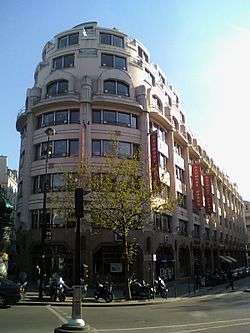Boulevard des Italiens
Coordinates: 48°52′17.11″N 2°20′13.19″E / 48.8714194°N 2.3369972°E
|
Buildings on the Boulevard des Italiens at the start of the 20th century | |
 | |
| Arrondissement | 2nd, 9th |
|---|---|
| From | Boulevard Montmartre |
| To | Boulevard des Capucines |
| Located near the Métro stations: Opéra and Richelieu - Drouot. |
The boulevard des Italiens is one of the four 'grands boulevards' in Paris, a chain running east west and also including boulevard de la Madeleine, Boulevard des Capucines and boulevard Montmartre. The origin of the name is the théâtre des Italiens built on it in 1783, shortly before the French Revolution (now replaced by the Opéra-Comique).
History
The boulevard's former names were:
- boulevard Neuf (= New boulevard)
- boulevard du Dépôt (boulevard of the barrack), because of a barrack installed in 1764 on the corner of rue de la Chaussée-d'Antin
- boulevard de la Chaussée-d'Antin
- boulevard Cerutti with the name of an hôtel on the boulevard (during the French Revolution)
- le petit Coblence ("little Koblenz") after 1795, since many émigrés returning to France during the French Directory gathered on it (Koblenz had been a popular exile destination for them)
- boulevard de Gand, on one side of the boulevard, under the second Bourbon Restoration, from 1815 to 1828 in memory of Louis XVIII's exile in Ghent during the Hundred Days.
Throughout the 19th century the boulevard was a meeting place for the elegant elite of Paris (a role that lasted until the First World War).
It was to replace Muscadins and Merveilleuses at the time of the Directoire, Gandins at the Restauration, Dandies during the reign of Louis-Philippe 1st, women in crinolines during the Second Empire.
That time was also a major epoque for several famous Cafés: Café de Paris, café Tortoni (the café Tortoni in Buenos Aires takes its name from that in Paris), café Frascati, café Français, Maison dorée among others. Upon completion of boulevard Haussmann in the 1920s these establishments disappeared to be replaced by other buildings, particularly financial ones.
Notable places

At the junction with rue Laffitte, a nice view of the Sacré-Coeur de Montmartre, which seems to be placed on the top of the Church Notre-Dame-de-Lorette, whereas in fact, it is much more distant.[1]

- at n° 8, the Théâtre Robert-Houdin, founded by the magician Jean Eugène Robert-Houdin and, in 1888, purchased and directed by Georges Méliès.
- At n° 13, the place of the former Café Anglais (1802-1913), well=known restaurant of the Second Empire, replaced by a building in the Art Nouveau style.
- At n° 16, the place of the former Café Riche (1791).
- At n° 19, Crédit Lyonnais headquarters, built from 1876 to 1913 in the Haussmann style.
- At n° 20, the place of the former luxury restaurant La Maison dorée (the Golden House) (1839-1841). Now the headquarters of the bank BNP Paribas, designed by Joseph Marrast, which retained the original facade (example of facadism).
- At n° 22, the place of the former Café Tortoni de Paris.
- At n° 26, the place of the former Cafe de Bade.
- At n° 36, a building created in 1929 by Michel Roux-Spitz. The ground floor was used as exposition hall for the Ford cars. Now, it is a fast food restaurant.[2]
At the corner of rue de la Chaussée d'Antin was the Dépôt des Gardes-françaises (French Guards' barracks) built by the colonel Duke of Biron in 1764. It gave the name of the boulevard for some years. On 12 July 1789, a platoon of the guards saved his colonel, Duchâtelet, from popular riots.[3]
At the corner of rue Louis-le-Grand, Palais Berlitz, built in the style of the 1930s in place of the Pavillon de Hanovre of the 18th century, which has been disassembled and rebuilt in the park of Sceaux.
Gallery
 View of the rue Laffitte
View of the rue Laffitte The place of the Café Anglais
The place of the Café Anglais BNP Paribas' head offices, with the facade of the former restaurant "la Maison Dorée"
BNP Paribas' head offices, with the facade of the former restaurant "la Maison Dorée"- Crédit Lyonnais' head offices
 The Palais Berlitz
The Palais Berlitz
References
- ↑ Paris, le guide vert. Éditions Michelin. ISBN 2-06-700352-6.
- ↑ Paris: 300 façades pour les curieux, Christine Bonneton editor, by Hélène Hatte & Frédéric Tran, June 2008, 17, avenue Théophile Gautier - Paris, 190 p., ISBN 978-2-86253-429-9.
- ↑ Le boulevard des Italiens on the website paris-pittoresque.com
External links
 Media related to Boulevard des Italiens (Paris) at Wikimedia Commons
Media related to Boulevard des Italiens (Paris) at Wikimedia Commons- Boulevard des Italiens on le site du Paris Pitoresque (French)
- Old postcards of Boulevard des Italiens, with the former buildings and cafes (French)